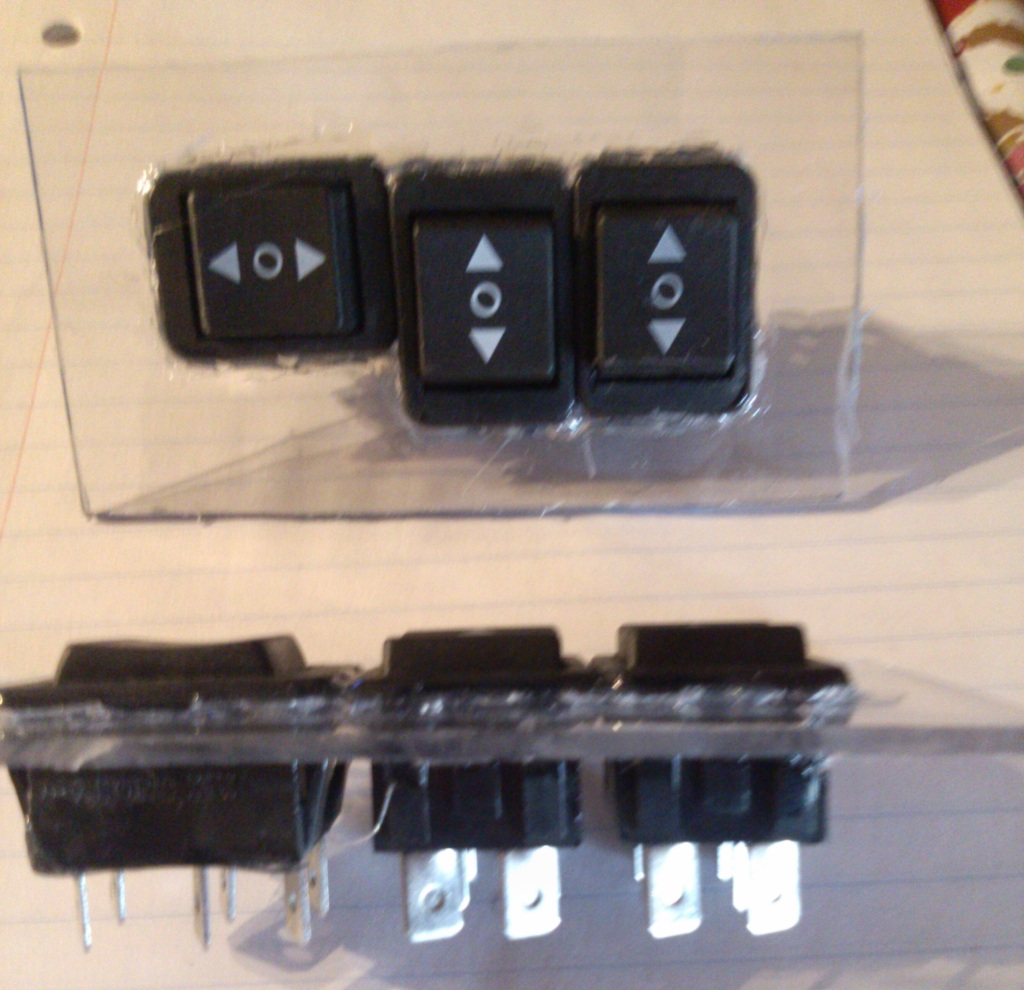My children have reached the milestone in life, where the state of Texas entrusts them, under supervision for now, to operate a motor vehicle. Without going in to details, the object of their foray in to driverdom is a 2001 Ford Explorer.
Knowing that the vehicle has power seats, and that the power seat switches were worn out, I Googled the problem, only to find that a replacement, specialized part, that Ford no longer makes, and that is poorly designed at inception, would cost between $200 and $400, and I needed TWO of them – both the driver’s side and passenger’s side were malfunctioning.
I asserted that I could fix it without the crappy Ford part, and I did.
[TOC]
The Nature of the Problem
After a couple of hours with a multimeter and toothpicks (non-conductive switch actuators), I was able to reverse-engineer how the seats work.
- There is a linear actuator that moves the seat forward or backward.
- There is a radial (angular) actuator, each, for front-tilt and rear-tilt
- Moving the seat “up” or “down” involves moving both tilt actuators in unison – move them both “up”, the seat moves up, move them both “down”, the seat moves down.
- The abomination hereafter referred to as the “ford seat switch” is designed to take a positive and negative terminal, and through manipulation of the various controls, provide forward or reverse current through the various actuators. Reversing the direction of the current reverses the movement of the actuator.
Summary
There are three actuators that move each seat. Each actuator needs forward or reversed current flow (6 primary states, 2 additional states if you raise or lower the seat)
Bad Design
Where do I begin?
Aaron: You know that story, about how NASA spent millions of dollars developing this pen that writes in Zero G? Did you ever read that?
Abe: Yeah.
Aaron: You know how the Russians solved the problem?
Abe: Yeah, they used a pencil.Primer, 2004
YES, this is an urban legend, as we all know that lead / graphite particles in zero G, floating around an hermetically-sealed space capsule filled with delicate, high-voltage electronics, and human lungs and eyes that react adversely to these substances is a BAD IDEA, but…. YOU GET THE POINT (no pun intended).
- The existing switch maintains contact to the positive terminal for all leads, all the time, until one of the buttons is pressed. This increases the likelihood that something could inadvertently short out. A component that’s NOT in use, should be NEUTRAL.
- The switch is proprietary. There are HUNDREDS of generic switches manufactured by reputable manufacturers, to do the exact same thing. Ford opted to design their own switch. And then stop making it.
- Like a relay, the Ford switch uses tiny pieces of copper that act as springs, with lead contacts. Relays wear out and MUST be replaced. Normal switches use steel springs and contacts that last for, basically, ever.
- The controls use Nylon contact points, that actuate the copper reeds, acting as switches. Nylon is awesome, but it WEARS OUT. Once the actuator “nubs” become slightly too short, or the copper reeds wear slightly too thin, or both, THE SWITCH NO LONGER SWITCHES. In electronic terms, the switch turns in to a BASIC CONDUCTOR. Because, it no longer “optionally” conducts – it just conducts. Like a WIRE conducts electricity.
- Clearances, special tools, and special procedures. If a part fails, you need to be able to get to the part to replace it. This is where Ford was kind enough to couple the seat control switch to LESS THAN ONE INCH of cable. Meaning, the seat panel in front of the switch can’t EASILY be maneuvered, and the seat switch itself can’t EASILY be removed. There are articles suggesting that the seat can be unbolted . a) WHY should there be a need to unbolt the seat? b) UNBOLTING the seat also involves unbolting the safety belt and other components, and is NOT straightforward.
Summary
The seat switch was specially-designed, unique to this vehicle, model, and year range, is no longer made, and is designed with internal components that are known to wear out. KNOWING that the part WILL FAIL, it can only be replaced using special tools and / or procedures.
THIS IS CALLED A “BAD DESIGN”
Good Design
Applicable design philosophies:
- Every part will eventually need to be replaced. DESIGN the car so that every part can be easily-accessed without the need for special tools or procedures.TWO screws connect the factory seat switch to the corresponding seat panel, but they must be accessed from the rear of the panel, where there is insufficient cable length to allow the proper tool clearance, requiring either a special tool, or a special procedure.
BETTER DESIGN: Use front-facing screws. Rear-facing screws were used because FORD thinks that people don’t like to see the screws – there are two viable alternatives:
a) Use flush-mount (bevel) screws, covered by a snap-off bezel.
b) Use forward-mounted screws and opt for the “industrial” look. Both of these options allow the “casual mechanic” to replace the part without worrying about clearance, special tools, or special procedures. - Use off-the-shelf (COTS – Commercial Off The Shelf) components. Ford had to pay some someone to sit down and design this switch. Then, they had to build a machine tool set to BUILD this piece of crap. THEN, Ford had to BUILD a certain number of these, and predictably, when demand fell, THEY STOPPED MAKING THEM.
BETTER DESIGN: Use COTS (Commercial Off The Shelf) components. NO EXCEPTIONS. “That custom look” or “that custom feel” can be obtained by GLUING BUTTON FACES to standard components. PC manufacturers have been doing this for two decades. Replacing a $3 switch is no problem. Replacing a highly-custom part that’s no longer in production is a huge issue.Rather than a copper monstrosity, a simple Double Pole Double Throw (DPDT) switch can be used to create an H-bridge – the “standard” approach for driving a reversible motor. Three actuators? Three switches. - Simple is reliable. Ford designed an overly-complex solution to a simple problem. As I recently heard in an episode of “Top Gear“,“You devised an elegant solution to a problem that never should have existed”. The concept of an H-bridge, a reversible circuit to drive a reversible motor, has been around since the early 1900’s. SINCE, THE BEGINNING OF ELECTRONICS. Some asshole decided that, rather than a simple control panel with three H-bridge circuits, a giant copper-reed monstrosity is MUCH BETTER!
BETTER DESIGN: Simple is better. Simple is reliable. Simple is repeatable. Use a DPDT switch. If you want that “custom” look, glue custom controls on top of the switch. This is simple, cheaper, user-replaceable, and will last much longer.
http://en.wikipedia.org/wiki/H_bridge - Use durable materials and designs. Anything you make out of plastic (Nylon) or copper WILL FAIL, because it WILL eventually wear out. Static components wear less, but dynamic components WILL eventually WEAR OUT. Anything that contacts something else dynamically, should be made out of the most durable materials. LIKE STEEL. NOT NYLON.
BETTER DESIGN: Use COTS DPDT switches with steel contacts and springs, that will last longer than the actuator!
Summary
Use design philosophies that predict component failure, allowing easy replacement with common parts, constructed with durable materials, requiring no special tools nor extensive procedures to replace them.
Fixing the Problem
Remove the Lower Seat Panel
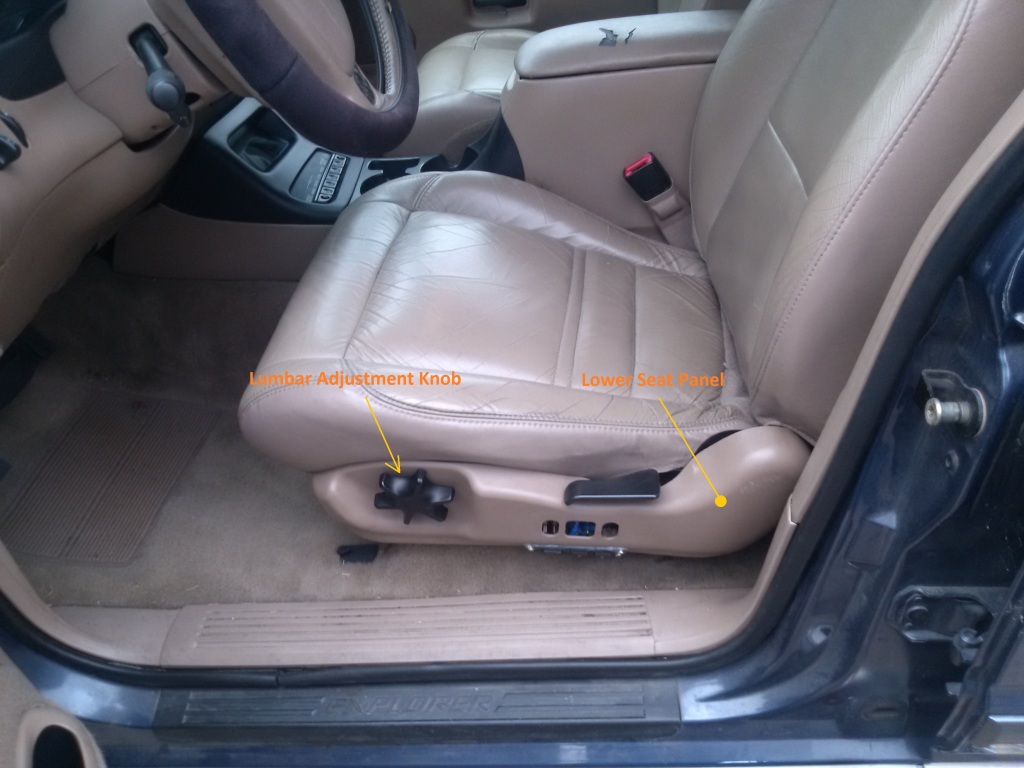
- Pull the lumbar adjustment knob perpendicular (away from the vehicle), and it will click loose.
- There is ONE screw beneath the lumbar adjustment knob, and one at the rear of the panel facing the back seat (it may be easier to access it from the back seat).
- There is a metal clip at the front of the panel, and a plastic notch at the rear, where the panel covers the seat hinge.
- Once the two screws are removed, start by clicking the metal clip loose, at the front of the panel (toward the front of the vehicle, just above the aperture for the adjustment knob), then rotate the whole panel slightly downward to click the rear tab loose, behind the part of the panel covering the seat hinge.
- Unscrew the switch. I used a 1/4″ ratchet with a #2 phillips bit. The two screws are behind the panel, at opposite corners of the switch.
Remove the Factory Switch
Here is what the factory switch looks like, disassembled:
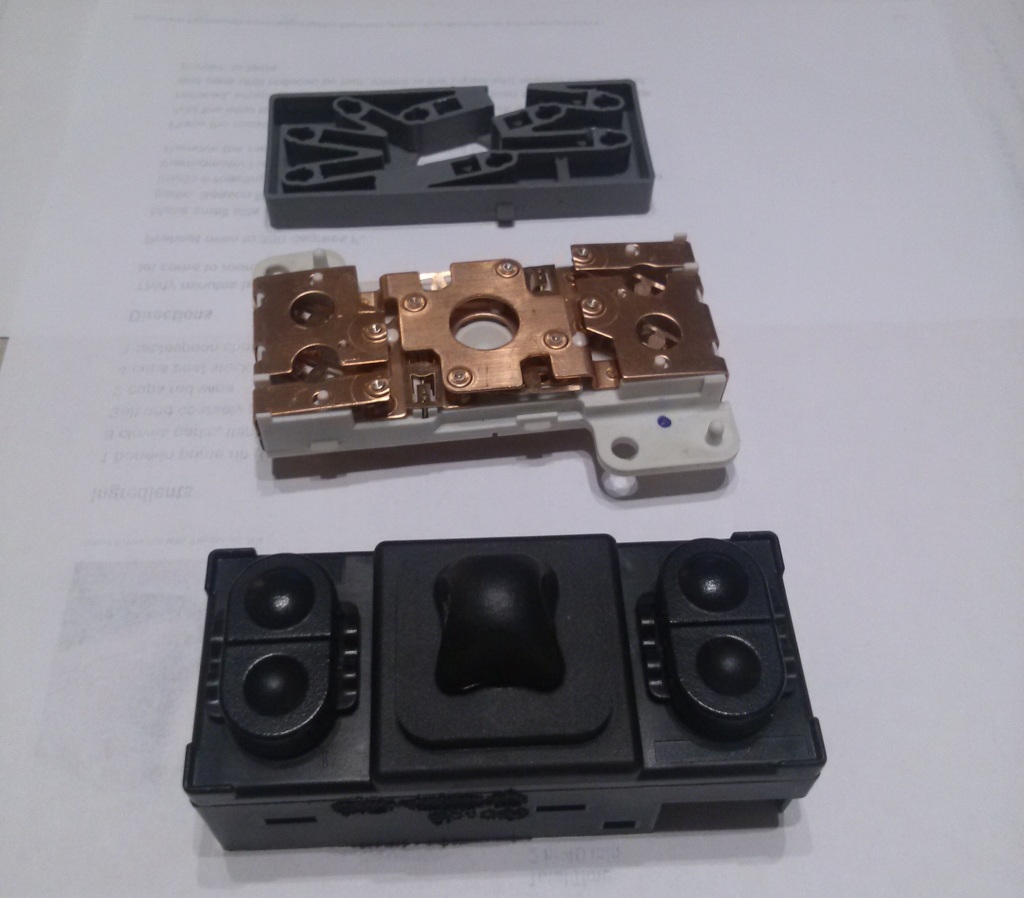
You can see that there are two front-tilt (up/down) buttons, a four-position seat movement switch, and two rear-tilt (up/down) buttons. The seat up/down position switch simply activates both the front and rear tilt functions in unison.
Note that the entire copper facing is connected to the positive lead, and is therefore “hot”! It would be a trivial matter to accidentally electrocute yourself or short this thing to ground while working on it. Therefore….
- DISCONNECT THE POSITIVE BATTERY TERMINAL BEFORE DISASSEMBLING THE SWITCH
- Carefully pry the switch cover loose, along the two sides where it is clipped to the base, where the wiring extends in to the seat. There is a tiny Nylon “nib” and spring inside the “hat” (4 position) switch, so be careful not to lose them!
- Carefully pry the switch mechanism from the base. There are 8 copper connector pins, joining the switch mechanism to each corresponding wire via a steel connector, which is clipped in to the base.
PIC - MAKE SURE THE POSITIVE BATTERY TERMINAL IS DISCONNECTED, because this is the part where you could melt a wire, blow a fuse, set something on fire, or electrocute yourself, resulting in permanent damage to the vehicle, or you dying in extreme pain.
- BEFORE REMOVING ANY WIRES, take a picture, and note the color of wire at each terminal position. I have a color chart and wiring diagram listed below, but, let’s just assume YOUR FORD is slightly different than mine.
- Each wire has a terminal that clips in, via a side-spring on the terminal, to the base. The spring clip must be moved toward the center from the side, and then the terminal must be eased from its aperture within the base.
- Carefully remove the base, leaving a mess of wires and connectors hanging out of the seat.
- Carefully clip the connectors off the end of each wire, leaving as much wire length as possible – I can’t emphasize how little clearance there is, to attach new connectors.
- Attach a female (indented) 14-16 gauge (blue) bullet connector to each wire. The reason to use the female (indented) bullet connector, rather than the male (exposed) bullet connector, is to allow the positive terminal of the battery to be reconnected, if needed, without a risk of shorting the positive terminal to ground, or to the negative terminal. Later, we will attach the corresponding male bullet connectors to the wiring from the replacement switch.
Purchasing or borrowing the higher-quality ratcheting crimp tool will definitely be worthwhile from a quality standpoint, and will save wear and tear on your hands!
The most effective method I found to crimp the connectors, was to stabilize the wire with bent-nosed pliers.
- Grab the wire with as much slack as possible with bent-nosed pliers (or a large hemostat would probably work)
- Use wire strippers to strip about 1/4″ of the insulation from the end of the wire
- Twist the wire end
- Slide the blue, female bullet terminal on to the tip of the wire.
- Holding the wire VERY STILL, insert the terminal and wire in to the “blue” slot of the crimp tool, and crimp the wire cautiously, so as not to dislodge the connector from the wire.
- Tug on the connector to make sure it doesn’t slip off easily. If it slips off, repeat. THIS is where the ratcheting type crimpers pay for themselves in a matter of minutes!
- The two black wires are the positive and negative terminals, and are slightly thicker. It may be convenient to use the slightly larger yellow (12-14 gauge) female connectors for these two wires, but the blue connectors should be used for everything else. I used the blue ones for everything – it’s a tight fit for the power terminals, but it worked.
Once all 8 female connectors are attached to the wires from the seat, there should be no exposed metal, and it’s safe to temporarily reconnect the positive battery terminal if needed.
It took me a couple of hours with toothpicks (insulators) and a multimeter to figure out which pins go with what functions.
Here is the color chart for the wires:
- Black, White Stripe: Positive
- Black (Solid): Ground
- White Stripe (Red, Yellow): Seat forward / backward
- Green Stripe (Red, Yellow): Rear Tilt up / down
- Blue Stripe (Red, Yellow): Front Tilt up / down
Here is a pic showing the terminal connections by wire color:
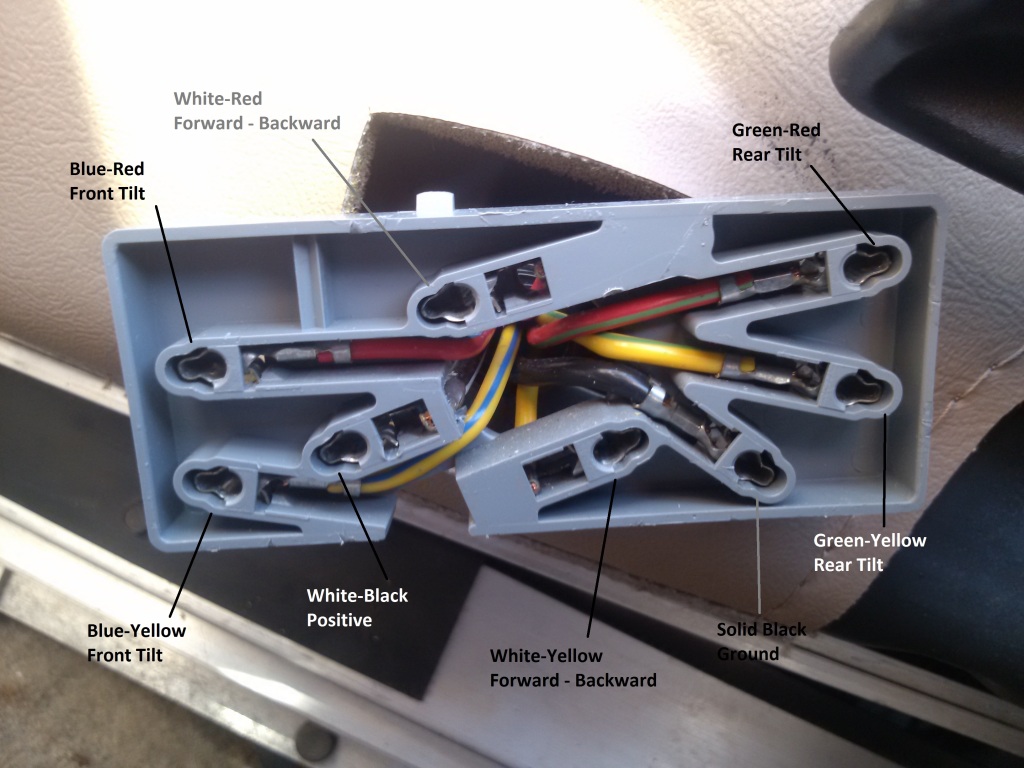
Build a Replacement Switch Console
I acquired 6 x DPDT momentary switches from Amazon. Each seat requires 3 switches:
- Forward – Backward
- Front Tilt, Up – Down
- Back Tilt, Up – Down
I used a Lexan panel, purchased from the hardware store, from which I cut a 5″ x 3″ panel, and then cut a rectangular aperture for each switch. I used E6000 craft glue to attach each switch to the new panel.
- Use a Dremel rotary tool with a cutting disc, or similar cutting tool to cut a 5″ x 3″ panel. If you are replacing both seat switches, cut two panels.
- Cut a rectangular aperture for each switch. I mounted the switches from left to right as follows:
- Seat forward – backward switch, so that the switch is actuated horizontally (pushing toward the front of the car moves the seat forward, etc)
- Front tilt, up – down, mounted vertically, so that touching the top of the switch moves the front tilt up, etc
- Rear tilt, up – down, mounted vertically, so that touching the top of the switch moves the rear tilt up, etc
- Mount the 3 switches in the respective apertures using E6000 craft glue, or clear epoxy.
Wire the Switch Terminals
Each wire from the seat connects to multiple switch terminals. The easiest way to accomplish this, is to use slightly oversized (12-14 gauge, yellow) female blade terminals for segments that are daisy-chained, and blue (14-16 gauge) connectors at each end.
As the original switches were designed to carry quite a bit of current, I used 14 gauge wire.
Purchasing or borrowing the higher-quality ratcheting crimp tool will definitely be worthwhile from a quality standpoint, and will save wear and tear on your hands!
If you can follow a wiring diagram, here is what we’re doing:
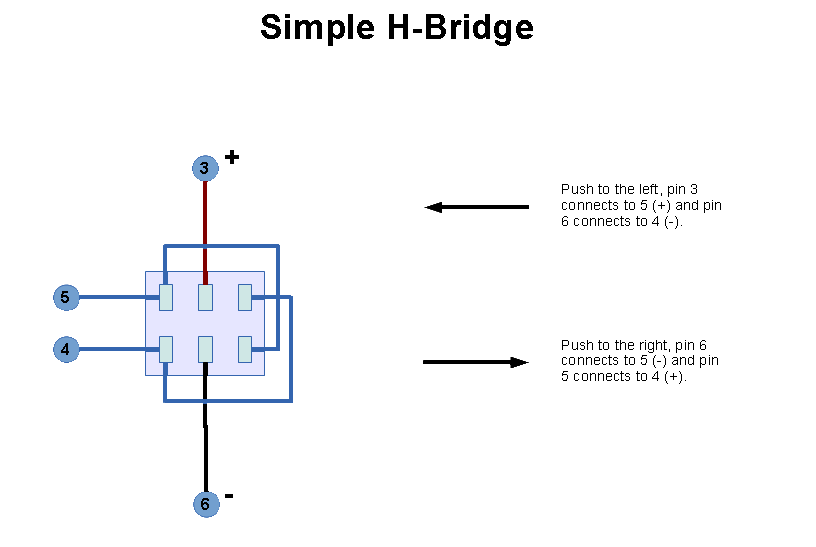
Each switch will act as an H-bridge: http://en.wikipedia.org/wiki/H_bridge
The function of an H-bridge is to allow 4 momentary connections to create two distinct current pathways across the actuator motor.
The first pathway, created when the switch is pushed “LEFT”, connects the positive terminal to terminal “1” of the motor, and the negative terminal from the power source, to terminal “2” of the motor. Current will flow from negative to positive, from terminal 2, through the motor, back to the switch through terminal 1, then back to the power source through the positive lead.
Pushing the switch “RIGHT” connects the positive terminal, through the jumper wire, to terminal 2 of the motor, and connects the negative lead of the power source, through the other jumper, to terminal 1. Now, current flows from the negative terminal, through the jumper to terminal 1, through the motor, back to the switch through terminal 2, then back to the power source through the positive lead.
In the neutral position, neither the positive nor negative terminals are connected to anything.
The whole circuit uses 3 of these switches, wired from the power source in parallel, each driving a pair of motor terminals:
PIC
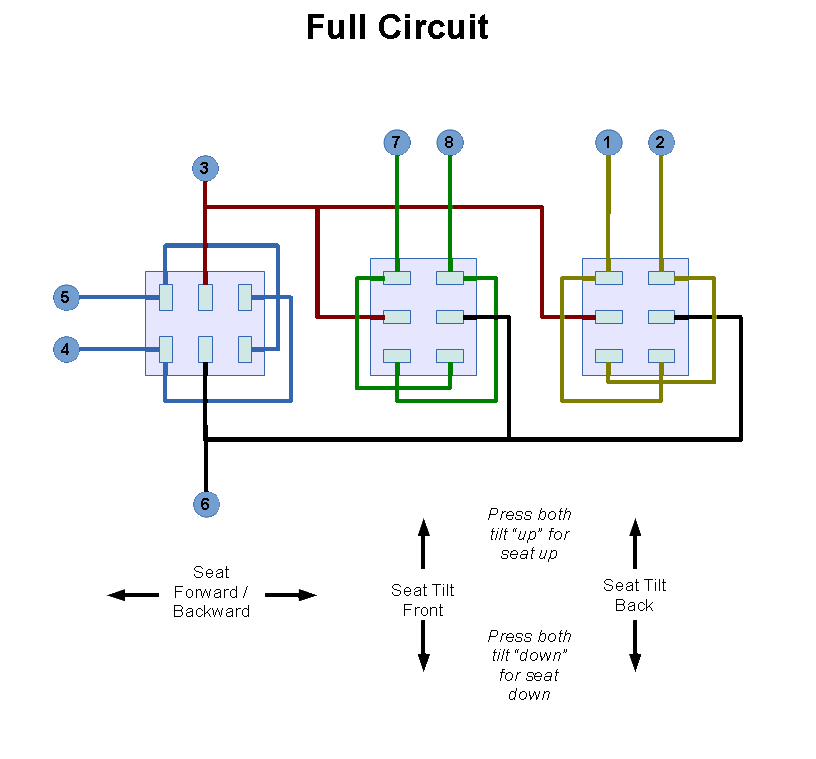
If you REALLY want a 4th switch for seat up-down, it simply has to be wired in parallel to BOTH tilt switches. I find it just as convenient to hit both switches at the same time for seat up-down.
If you can follow a wiring diagram, wire the switches to the male bullet connectors as above. If not, follow the procedure below.
The following procedure and materials are for ONE seat – double the materials and repeat if you are doing BOTH seats.
- Cut the following wire lengths (18 total):
- 8 x 5″
- 10 x 2″
- Strip 1/4″ of the insulation from both ends of each wire (all 18, stripped on both ends)
- Build 6 of these (1 x 5″ and 1 x 2″):
- One a 2″ piece of wire, twist one end of the wire, and crimp a blue (14-16 gauge) female blade terminal. Make sure there is no exposed wire, and that the connection is secure – tug on it firmly to make sure it doesn’t pop off.
- Twist the other end of the 2″ wire to one of the ends of a 5″ wire. The result should resemble a “V”, as you would do before using a wire nut.
- Crimp a yellow (12-14 gauge) female blade connector to the twisted junction of the 5″ and 2″ wire. Tug each wire to make sure it’s mechanically-secure.
- On the remaining end of the 5″ wire, crimp a blue (14-16 gauge) male bullet connector. Tug to make sure the wire is secure.
- The final product should resemble a “V” with two segments.
- Build 2 of these (1 x 5″ and 2 x 2″ – just like above, but with an extra 2″ segment):
- One a 2″ piece of wire, twist one end of the wire, and crimp a blue (14-16 gauge) female blade terminal. Make sure there is no exposed wire, and that the connection is secure – tug on it firmly to make sure it doesn’t pop off.
- Twist the other end of the 2″ wire to one end of a SECOND 2″ wire. The result should resemble a “V”, as you would do before using a wire nut.
- Crimp a yellow (12-14 gauge) female blade connector to the twisted junction of the TWO 2″ wires. Tug each wire to make sure it’s mechanically-secure.
- Twist the other end of the SECOND 2″ wire to one of the ends of a 5″ wire. The result should resemble a “V”, as you would do before using a wire nut.
- Crimp a yellow (12-14 gauge) female blade connector to the twisted junction of the 5″ and SECOND 2″ wire. Tug each wire to make sure it’s mechanically-secure.
- On the remaining end of the 5″ wire, crimp a blue (14-16 gauge) male bullet connector. Tug to make sure the wire is secure.
- The final product should resemble a “Z” or zigzag, with 3 segments.
- The 3-segment wires are the power leads, while the 2-segment wires are the motor leads.
- All wiring is done with the switch “button” on the table, and the switch’s blade terminals facing you. The horizontally-mounted (forward-backward) switch should be on your left for the driver’s side, or on your right for the passenger’s side.
- Mark one of the 3-segment wires “WHITE”. I wrapped a small piece of white-colored electrical tape around the insulation of the 5″ segment.
- Connect the female blade end of the 5″ segment of the white (3-segment) power lead to the upper-middle terminal of the HORIZONTAL (forward-backward) switch.
- DRIVER: Connect the middle female blade terminal (joining the 2″ segments) to the LEFT-middle terminal of the middle VERTICAL (front tilt, up-down) switch
PASSENGER: Connect the middle female blade terminal (joining the 2″ segments) to the RIGHT-middle terminal of the middle VERTICAL (front tilt, up-down) switch - Connect the remaining blue female blade terminal to the corresponding switch terminal on the last VERTICAL (rear tilt, up-down) switch – match the same position for DRIVER or PASSENGER above (left or right, accordingly)
- Connect the remaining BLACK power wire to the OTHER middle switch terminals – bottom-middle of the HORIZONTAL switch, RIGHT-middle of the other two switches for the DRIVER’s side, or LEFT-middle for PASSENGER (connect the black cable to the only other open, middle terminal of each switch)
- Label one of the motor wires “WHITE RED”
- For all remaining wires, stick with DRIVER = left, PASSENGER = right. The instructions below assume DRIVER, just reverse left and right for PASSENGER.
- Connect the yellow connector of the WHITE RED wire to the upper-left (DRIVER’s side) terminal of the HORIZONTAL (forward-backward) switch.
- Connect the blue connector of the WHITE RED wire to the lower-right (opposite corner) terminal of the HORIZONTAL switch.
- Label one of the motor wires “WHITE YELLOW”
- Connect the yellow connector of the WHITE YELLOW wire to the lower-left terminal of the HORIZONTAL switch.
- Connect the blue connector of the WHITE YELLOW wire to the upper-right terminal of the HORIZONTAL switch.
- Label one of the motor wires “BLUE RED”
- Connect the yellow connector of the BLUE RED wire to the upper-left terminal of the MIDDLE VERTICAL switch (front tilt, up-down)
- Connect the blue connector of the BLUE RED wire to the lower-right terminal of the MIDDLE VERTICAL switch
- Label one of the motor wires “BLUE YELLOW”
- Connect the yellow connector of the BLUE YELLOW wire to the upper-right terminal of the MIDDLE VERTICAL switch
- Connect the blue connector of the BLUE YELLOW wire to the lower-left terminal of the MIDDLE VERTICAL switch.
- Label one of the motor wires “GREEN RED”
- Connect the yellow connector of the GREEN RED wire to the upper-left terminal of the RIGHT VERTICAL switch (rear tilt, up-down)
- Connect the blue connector of the GREEN RED wire to the lower-right terminal of the RIGHT VERTICAL switch
- Label the final (-whew-) motor wire “GREEN YELLOW”
- Connect the yellow connector of the GREEN YELLOW wire to the upper-right terminal of the RIGHT VERTICAL switch
- Connect the blue connector of the GREEN YELLOW wire to the lower-left terminal of the RIGHT VERTICAL switch.

Ready to Test
- Connect the new switch panel to the vehicle using the bullet connectors, to test. WHITE matches black-with-white-stripe at the seat. BLACK matches black, WHITE RED matches red-wire-with-white-stripe, etc…
- CONNECT THE POSITIVE BATTERY TERMINAL
- If you’ve accidentally connected the two power terminals to each other at this point, you can expect a loud “pop” followed by a melted wire or blown fuse.
- Again, if I’ve accidentally reversed any of the instructions, or if you wired it backward, just reverse RED and YELLOW when connecting to the seat – e.g. if you connect WHITE-RED and WHITE-YELLOW to the corresponding wires at the seat, and forward and reverse are swapped, then just swap the WHITE-RED and WHITE-YELLOW wires.
- Repeat for green stripe pair
- Repeat again for blue stripe pair
- Make note of any final wiring discrepancies, so that you know how to wire it correctly when it’s ready to be mounted.
- DISCONNECT THE POSITIVE BATTERY TERMINAL
- Carefully disconnect all 8 bullet connectors, and carefully remove the new switch panel.
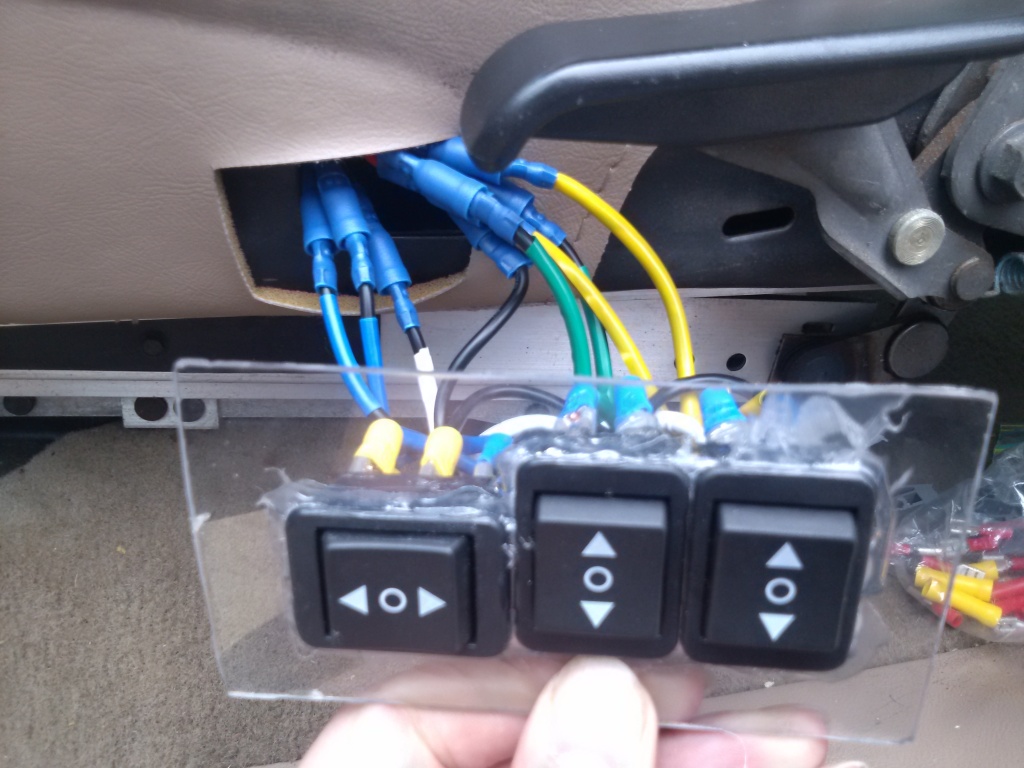
Mount the New Switch Panel
Obviously, the new switches aren’t going to match the existing holes in the lower seat panel.
I cut a rectangular notch at the very bottom, which also allows clearance for the slightly deeper switches / wires.
Leaving overlap, I cut the notch so that all four corners of the Lexan switch panel could be screwed to the seat panel, using a machine screw and nut at each corner.
I clamped the switch panel to the seat panel (carefully), and drilled a 3/16″ hole through both, then inserted a #8-32 x 1/2 machine screw through the front, securing in the rear with a nut.
If you wish to cover the original holes, I suggest using epoxy to attach a smaller Lexan panel behind the holes, then use epoxy putty to smooth them over. Once dry, the epoxy putty can be painted. I opted NOT to do this, as it’s not that noticeable.
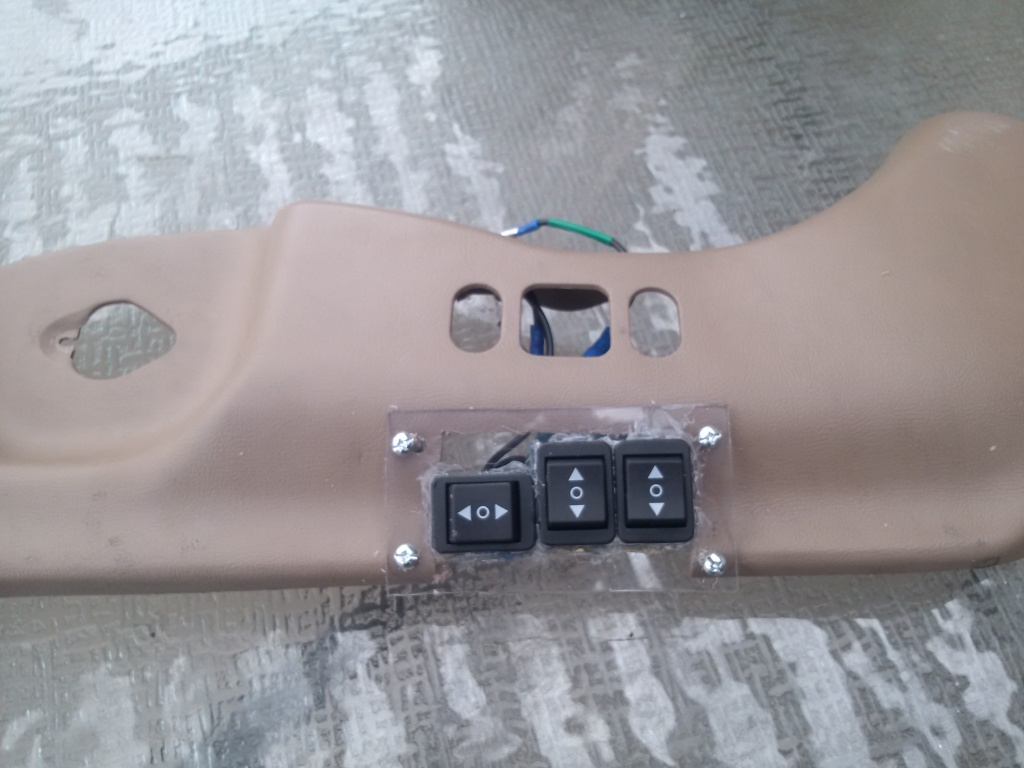
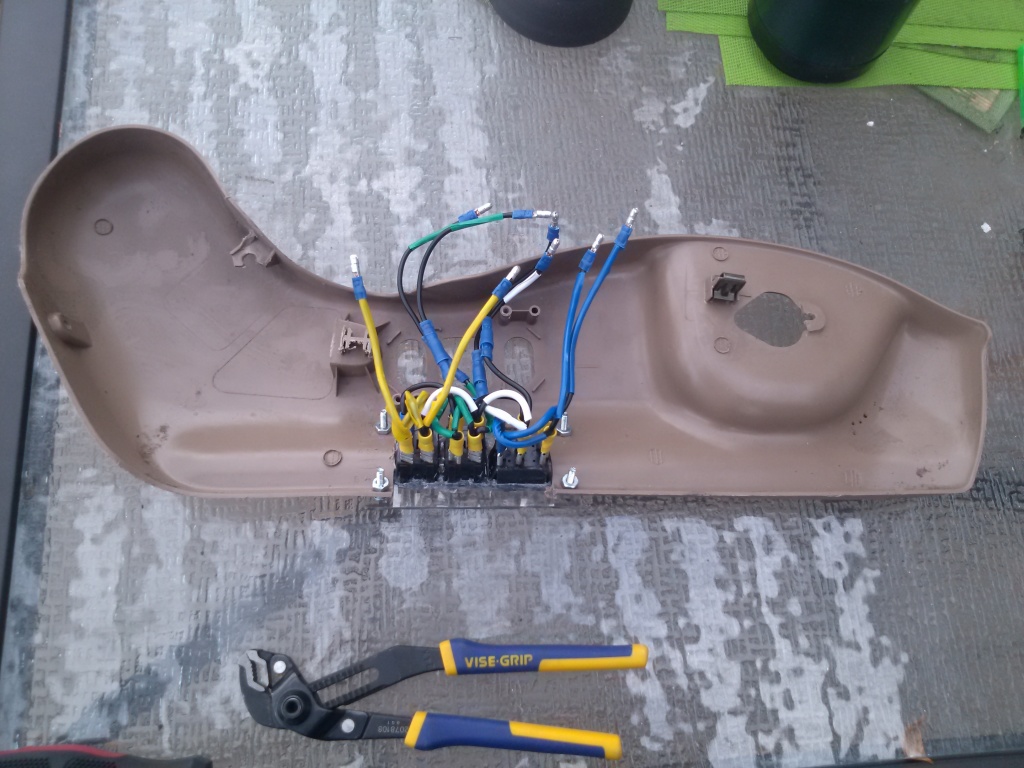
Finish Up
Reconnect the switch panel to the seat’s wires using any final wiring notes to make sure each switch functions properly.
Use small 3″ zip ties to bundle the wires and provide strain relief. This will prevent the blade terminals from wiggling loose over time.
Re-attach the lower seat panel. Clip the hinge-side on first, then insert the metal clip in to the aperture above the tube for the lumbar adjustment knob. Restore both screws – one near the knob, one at the rear (you may need to access it from the back seat).
Firmly push the lumbar adjustment knob in to its tube until it clicks in to place.
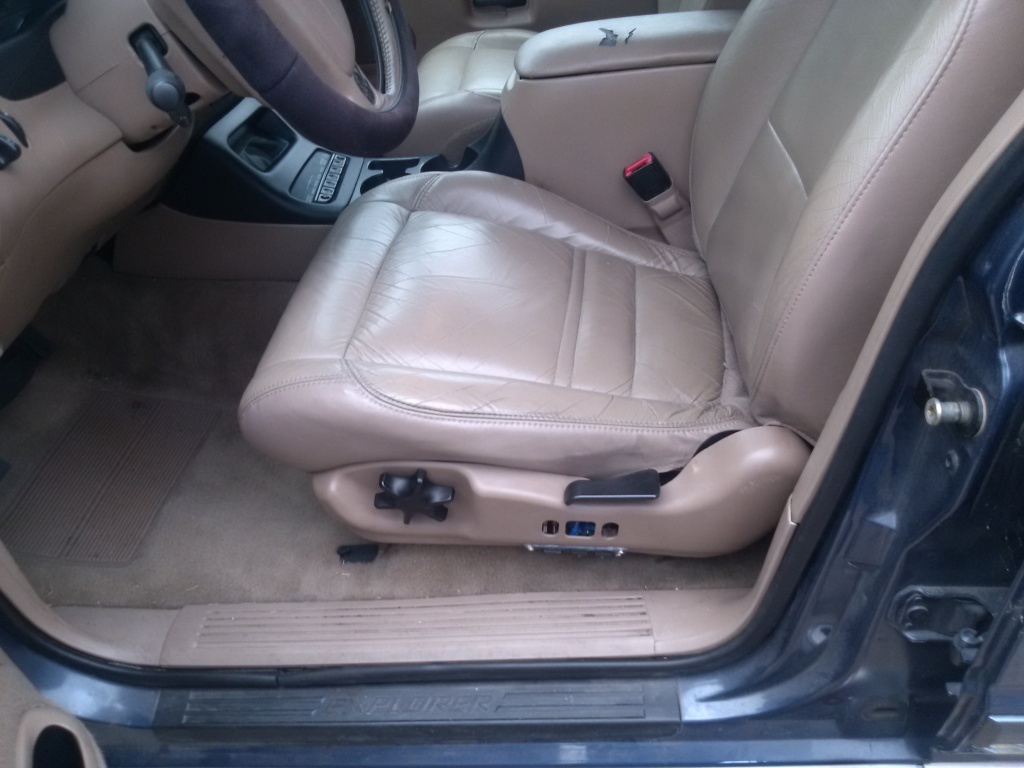
Summary
Let’s compare my solution to FORD’s:
- My solution used $11 worth of switches and $5 worth of standard terminal connectors. Ford used a completely proprietary part, connected to the actual wires using completely proprietary connectors.
- If the Ford part breaks, it’s difficult to replace because there is insufficient slack in the seat’s wires, to allow clearance to insert a tool to remove the seat panel. If my part breaks, pop the seat panel off, there is now 3″ or more of slack, and pop loose the 8 bullet connectors. Any repairs / replacements can be accomplished quickly and easily.
- The Ford part used copper and Nylon, not the most durable materials. My solution used industrial grade switches with steel springs and contacts, and will VIRTUALLY NEVER wear out.
- The Ford solution provided a “cool looking” 4-way hat switch for moving the seat, that in reality, was WAY overcomplicated, resulting in a product that was WAY overengineered. I think most people understand the concept of pushing two switches at once, to raise or lower the seat. If you don’t like my switches, glue a custom button face on them.
- If someone spills a drink on my switch panel, there is very little chance that it will short the positive lead to the ground lead. With the Ford switch, the entire switch is “hot” the entire time, with only 1/16″ or less separating the positive and negative terminals for the various functions. If you mash on the switch in the wrong way, it can activate multiple functions and short out. If someone spills a drink on it, IT WILL short out.
Unfortunately, the Automotive industry is rife with this type of problem. To all of you engineers out there, whether you work for an auto company or not, DON’T BE FORD. DON’T take the NASA approach, when all you need is a pencil!
